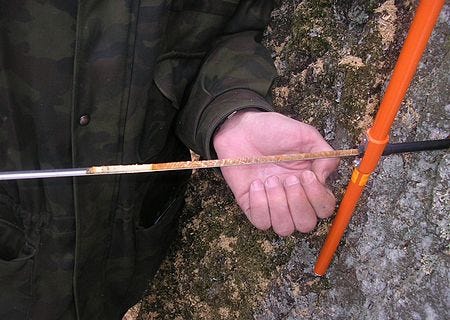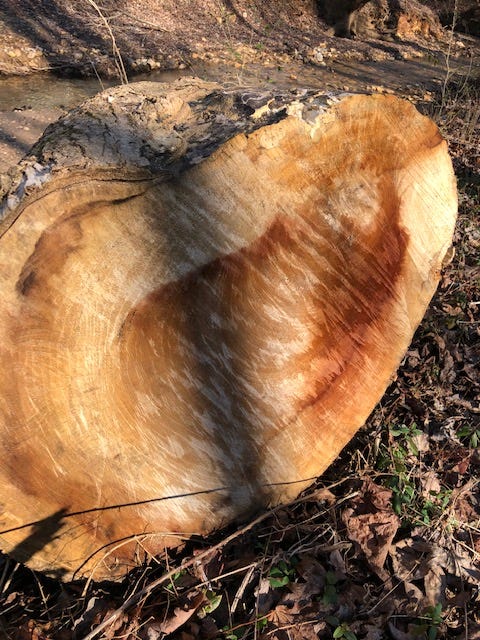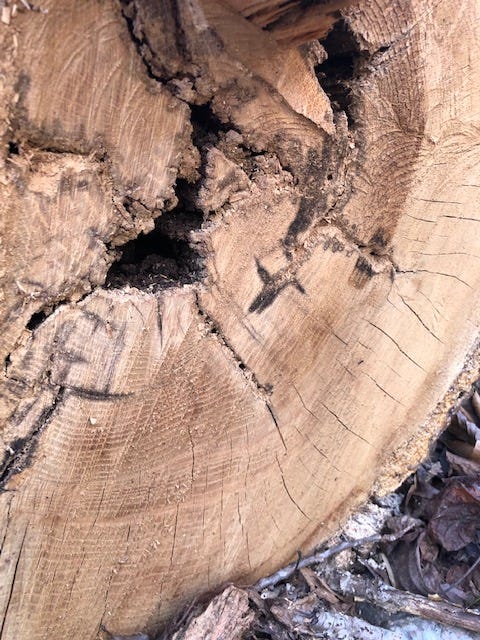If you enjoy this newsletter (and I hope you do!), would you do me a small favor and take a moment right now to forward it to 3 of your friends who you think would also enjoy it? Increasing subscribership makes me happy and I’m hoping reading this newsletter makes you happy enough to recommend it to other folks. Everyone likes a little bit of Nature in their inbox each week! Click the button below to share.

Last week I wrote about Indian Pointing Trees, and I heard from quite a few of you who have either A) seen them yourselves and think they’re fascinating or B) believe most of the “Marker Trees” around today couldn’t possibly be the real thing because they’re not old enough. I’ll admit, that’s one of the reservations I have about the trees I’ve found. The time when Native Americans roamed our mountains is quickly receding into the past, so could these trees have even lasted this long?
I’ve looked at trees differently as I hiked and biked through the woods this past week. How old are the trees that are possibly Marker Trees? How old is this random red oak, anyway? Do different tree species age at the same rate? Ultimately, I found that I mostly wondered:
How can I tell how old a tree is without cutting it down?
The absolute best way to tell the age of a tree is, of course, to cut it down and count the rings. Trees contain layers inside their trunks – the cambium, just inside the protective bark, is the life-giving layer stuffed full of sugar and minerals. It forms bark on the outside and wood cells on the inside. This is the part that bark beetles crave and, according to Peter Wohlleben, it is edible for humans as well, if you’re hungry enough. Apparently, it tastes like carrots.

At any rate, the cambium adds a layer to the tree every year. Each ring consists of a light color with a dark outline. The light-colored wood forms in the spring and early summer while the dark outline is formed in the late summer and fall.
Reading the rings tells the story of the tree – widely spaced rings mean lots of growth that year, perhaps because it was wet and nutritious or the winter was short. Narrowly spaced rings could mean drought or insect infestation. Or, if the rings are narrow on one side, it might mean the tree was leaning against an object there, or experienced heavy wind load on that side. Dark blotches inside the tree might be evidence of damage from a forest fire that burned through the bark into the cambium.
Take a look at the story this chestnut oak tells:
If you look carefully at the innermost section of the trunk, you’ll see two “piths” or centers to the tree. This means this tree originally began as two trees, but fused together to become one. It’s apparently not that uncommon. I counted the rings on this oak from the larger of the two piths and found that it was 31 years old.
But what if I want to know the age of a tree that’s still standing upright with its rings hidden inside?
One fairly reliable method is to core it. Don’t confuse this with the vertical coring of an apple or a pineapple – coring a tree simply means taking a small horizontal sample from the inside of the tree. To do this you use a tool called an increment borer, which looks like a long, T-shaped screw with a hollow center. By spinning it into the center of the tree, you can pull out a small slice, or core, about the size of a straw that allows you to count the rings and study the distance between them. People who study tree rings are called dendrochronologists, and this video shows a cool demonstration of how it’s done.

In the photo above, the dendrochronologist has pulled the sample out of the borer in order to study the rings. Notice the lighter-colored sapwood on the left, which was nearest the outer bark. The darker wood towards the right is the heartwood. In general, it’s thought that trees easily heal themselves from the slight damage that coring a tree creates. Within a year or two the holes appear to be healed, in the same way that maple trees heal from being tapped for syrup.
Several of the Indian Pointing trees that have been entered in the Mountain Stewards database that I mentioned in last week’s newsletter have been cored and found to be several hundred years old. It’s a good way of verifying the likelihood of a Marker Tree being old enough to be genuine.
However, I don’t own an incremental borer, and I still want to know how to estimate the age of a standing tree. What to do?
It turns out there are ways to estimate a tree’s age based on its diameter. Yay! The process is simple – measure the circumference of a tree at breast height (approx. 4 ½ feet from the ground), divide by pi (or use a handy app like I did) to determine the diameter of the tree, then multiply that diameter by the growth factor for that species of tree. Fairly simple, right?
Well, no… it turns out there is little consensus on accurate growth factors for various species. One site told me the growth factor of red oaks is 4.0. That would make a 10-inch-diameter tree around 40 years old. Another site said the red oak growth factor is 6.7, making the same tree about 67 years old – big difference! A third option was a table by the Morton Arboretum that charted growth in a nonlinear fashion and thus allowed for variation across the years. But on that chart a 10-inch red oak would be 55 years old. Nobody agreed!
In all fairness, the growth of a tree is incredibly sporadic – it’s not realistic to say ALL red oaks will regularly grow an inch over four years, like the first growth factor site suggests. Too many factors can affect a tree’s growth – drought, bugs, light sources, late frost that kills baby leaves, access to a water source, etc.
With such variations in suggested growth rates, I figured the only way to decide who to believe was to go to empirical evidence – I needed to find some recently-cut trees where I could both count the rings AND measure the circumference. That would tell me which growth rate sites to trust.
First, I counted the rings of an enormous poplar tree we’d cut after it finally leaned too far and fell into the creek.
This was an oddly-shaped tree with the pith of the tree very off-set from its actual center (you can see it in the upper righthand corner of the photo). For some reason, this tree grew much bigger on one side than the other – why? Most likely, the larger side of the tree developed to brace the tree as it leaned out over the creek. Over the course of its life the roots became more exposed as dirt washed away in floods, causing it to lean even farther and become more stressed. Ultimately, it couldn’t take the pressure and fell.
The diameter of the tree was 25 inches. According to the growth rate chart, it should have been around 75 years old. When I counted the actual rings, it turned out to be just 58 years old. It’s “fatter” than a tree of its age would normally be, but that makes sense because its roots were embedded in a creek for most of its life. Zoom into the photo and you can see lots of very wide rings, indicating fast growth for many years.
I found this recently-cut red oak on our neighbor’s property:
The inside of this tree had a lot of character – several splits, a rotten center, and dark areas that could be rot or sign of forest fire. Notice that this tree, up on a ridge far away from the creek, has much tighter rings. Red oaks are also slower-growing trees than poplars – the growth rate chart estimates red oaks to take 4 years to grow an inch, while poplars can accomplish that in three. The rotten center of this tree made accurate counting of the rings difficult, but I found it to be around 80 years old. Based on its 29.3-inch diameter, the growth rate predicted it to be 117 years old. That’s not actually too far off!
For both of these trees, I used growth rate data from the first site I mentioned because the second site was either missing data (no growth rate for poplars) or wildly off-base (it predicted the red oak to be 196 years old).
I replicated comparisons between growth rate predictions and actual ring counting with a couple yellow pines and another small poplar and found the growth rate predictions to be only about 10 years off in each case. So, it seems that measuring the circumference of a tree can give you a good estimate of the tree’s age IF you use growth rate predictions from the Morton Arboretum.
Now, I just need to revisit the Indian Marker Trees I’ve seen and bring a tape measure…
Prompt: find a large tree near you, one that you think might be 100 years old or more (perhaps one so big you can’t wrap your arms around it). Take some time to think about what this tree has witnessed in that time. What was the world like when it was a tiny sapling? How might the area around it look different now compared to then? What advice might the tree might give us if it could talk?
What do you think? Have you seen an incredibly old tree or counted tree rings before? Do you have a large tree living near you? Try measuring the trunk circumference and let me know what you find out!
Weird Nature of the Week
Detritus
Check out this White Oak near me that’s thought to be one of the 10 oldest in the United states.
Not nature, but this street art is amazing and this video shows the artist in action
Test your knowledge of your region: 30 questions to elevate your awareness (and literacy) of the greater place in which you live
Did you know that in many languages, the word for “raccoon” translates as “wash bear”?
If you like getting nature-based newsletters in your inbox, check out my friend Cole’s newsletter, Cole’s Climb. Cole is in Colorado and writes/reflects about all things outdoors - snowboarding, hiking, the Olympics, and lessons to be learned from being outside. Check it out!







Fascinating, thank you. I've enjoyed counting tree rings when I've had the chance. It's surprisingly tricky.